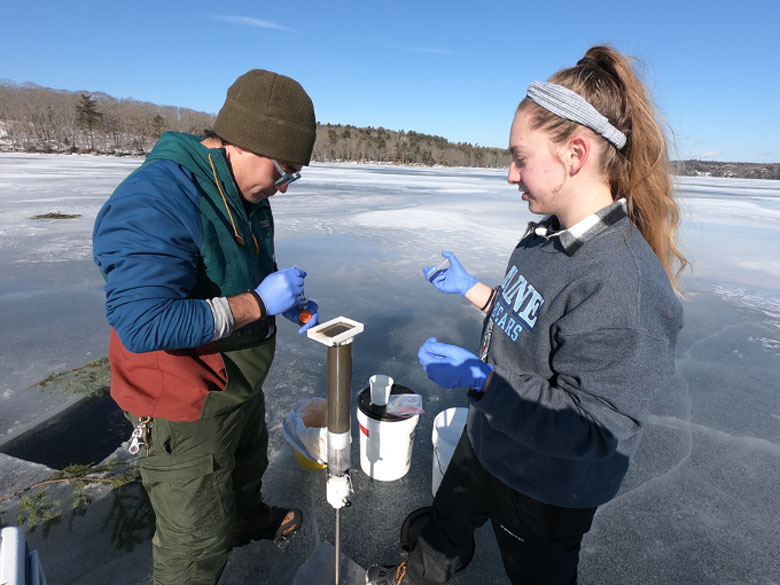Mariners may claim the ocean is in their DNA, but it’s also literally true that the ocean is full of DNA. All ocean life—indeed, all aquatic life—sheds DNA into the water. The goal of the Maine eDNA project is to read the DNA that’s in the water to understand what it can tell us about what’s going on beneath the waves.
To refresh high school biology, DNA stands for deoxyribonucleic acid, the molecule made up of four bases, A, G, C, and T for short. Different combinations of these four bases form the living blueprint that defines us all, from the tiniest microbe to the largest whale.
While the DNA molecule is shared by all species, it is differences in the arrangement of the four letters that help define one species from another, and small mutations in DNA can even distinguish one individual from another.
Tracking larva can tell you the current status of the fishery, and what future years might look like.
Thanks to years of work in DNA science, we have a variety of ways to quickly read millions of DNA sequences with great accuracy, or probe for species specific sequences in a complex DNA soup.
Collecting eDNA is its own kind of fishing expedition. We take samples of water from different depths, usually around a quart (a liter for metric buffs) and pass it through a very fine filter that catches all the particles including cells or parts of cells that may contain DNA. A chemical DNA extraction kit is used to capture only the DNA molecules from the filter.
With DNA in hand, there are a couple of choices. You can use a “general primer” to make millions of copies of everything thing that’s there and then DNA sequence the lot to see who’s who, or you can use a “species specific primer” and make copies of only a single species.
In this latter case, the actual number of DNA copies you get back provides an estimate as to species abundance. Of course, I am glossing over a ton of details, and no shortage of devils that lie therein. As scientists we delight in outwitting the devils, even though some of them keep us up at night.
There are lots of applications for eDNA. A primary objective of the Maine eDNA project is to test the science behind these applications to find out what works and what doesn’t.
This project, funded the National Science Foundation, is a collaboration between the University of Maine and Bigelow Laboratory, and a host of other institutions around the state. Much of the money goes to support a new generation of scientists, graduate students, and undergrads who are testing these eDNA applications. Our ambition is to make Maine a research hotbed for eDNA, and for Maine to become the “eDNA coast.”
Detecting larval DNA is an interesting area we are exploring, especially if you can tell a larva from an adult based only on its genetic signature. This is important for scallops or mussels, since tracking larva can tell you the current status of the fishery, and what future years might look like.
Another project is focusing on kelp beds and how they are responding to the rapidly warming waters of the Gulf of Maine.
Researchers are finding many more species of fish associated with kelp forests using eDNA than are observed visually. This raises questions about whether these species are transient or using kelp as an important habitat.
As the seawater temperature warms, kelp forests in Southern Maine are giving way to other types of algae, so this raises the question about how these fish communities may respond.
A couple of graduate students are testing eDNA fish detection alongside the traditional trawl or accoustic surveys that the Department of Marine Resources uses to assess fish stocks. The goals aren’t so much to replace these traditional methods as to show that eDNA can deliver similar results and at cheaper cost. This could ultimately allow much more data to be collected for the same effort and improve the accuracy of fisheries surveys in predicting the impacts of fishing pressure on different species.
Someday it may be possible for commercial or recreational fishers themselves to conduct eDNA-based fish surveys using handheld devices, or even simple colormetric tests similar to the ubiquitous COVID tests.
Using eDNA for conservation and environmental monitoring is being widely adopted across the U.S. and around the world. Federal agencies like NOAA, EPA, and the U.S. Fish and Wildlife Service are instituting eDNA tools in their various monitoring programs. In Maine, eDNA researchers are working with the DMR, the Department of Environmental Protection, and other state agencies. These agencies may adopt eDNA methods as standard practice.
In addition to government agencies, Maine eDNA researchers are working with lake associations, non-profits, and towns to help them track harmful algal blooms. We also are working with aquaculturists to help them monitor for possible pathogens, as well as predict locations that might be best for siting growing sites to reduce environmental impacts and maximize recruitment of natural setting species.
We are now in the last year of the NSF-funded project, but we are confident we are building capacity to keep Maine at the forefront of eDNA research and applications for years to come.
David Emerson is a senior research scientist at Bigelow Laboratory for Ocean Sciences in East Boothbay.





